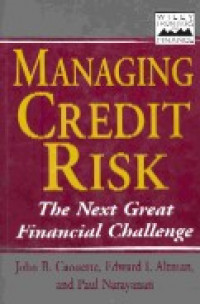
Managing credit risk : the next great financial challenge
| Gmd : Text
| Availability :
| 00000009672 | HG3751 .C32 1998 REF | (Reference) | Available - Ada |
| 00000009867 | HG3751 .C32 1998 REF | (Reference) | Available - Ada |
Examines the major players & institutional setting for credit risk, including banks, insurance companies, pension funds, exchanges, clearing houses, & rating agencies, & offers a comprehensive guide to the rapidly changing marketplace for credit products.
The phenomenal growth of the credit markets has spawned a powerful array of new instruments for managing credit risk, but until now there has been no single source of information and commentary on them. In Managing Credit Risk, three highly regarded professionals in the field have for the first time gathered state-of-the-art information on the tools, techniques, and vehicles available today for managing credit risk. Throughout the book they emphasize the actual practice of managing credit risk, and draw on the experience of leading experts who have successfully implemented credit risk solutions.
Starting with a lucid analysis of recent sweeping changes in the U.S. and global financial markets, this comprehensive resource documents the credit explosion and its remarkable opportunities as well as its potentially devastating dangers. Analyzing the problems that have occurred during its growth period S&L failures, business failures, bond and loan defaults, derivatives debacles and the solutions that have enabled the credit market to continue expanding, Managing Credit Risk examines the major players and institutional settings for credit risk, including banks, insurance companies, pension funds, exchanges, clearinghouses, and rating agencies. By carefully delineating the different perspectives of each of these groups with respect to credit risk, this unique resource offers a comprehensive guide to the rapidly changing marketplace for credit products.
Managing Credit Risk describes all the major credit risk management tools with regard to their strengths and weaknesses, their fitness to specific financial situations, and their effectiveness. The instruments covered in each of these detailed sections include: credit risk models based on accounting data and market values; models based on stock price; consumer finance models; models for small business; models for real estate, emerging market corporations, and financial institutions; country risk models; and more. There is an important analysis of default results on corporate bonds and loans, and credit rating migration. In all cases, the authors emphasize that success will go to those firms that employ the right tools and create the right kind of risk culture within their organizations. A strong concluding chapter integrates emerging trends in the financial markets with the new methods in the context of the overall credit environment.
Concise, authoritative, and lucidly written, Managing Credit Risk is essential reading for bankers, regulators, and financial market professionals who face the great new challenges and promising rewards of credit risk management.
About the Author
JOHN B. CAOUETTE is President of the Structured Finance Division of MBIA Insurance Corporation. He was formerly Chairman and CEO of Capital Markets Assurance Corporation.
EDWARD I. ALTMAN is the Max Heine Professor of Finance at New York University Stern School of Business and Vice Director of its Salomon Center. His previous publications include Corporate Bankruptcy in America and Corporate Finance and Bankruptcy (Wiley).
PAUL NARAYANAN is a credit and financial risk consultant who has worked in risk management at Chase Manhattan Bank, BankBoston, and Meritor PSFS. He is cobuilder of the Zeta model and has designed and implemented risk models for consumer, residential, and corporate sectors.
Table of Contents:
Credit Risk: The Next Great Challenge of the Financial Markets.
Credit Culture.
Classic Industry Players Banks, Finance Companies, Insurance Companies, Industrial Companies.
Portfolio Managers Investment Managers Unit Trusts, Mutual Funds, Pension Funds.
Structural Hubs Derivative Dealers, Clearinghouses, and Exchanges.
Rating Agencies.
Classic Credit Analysis.
Asset-Based Lending.
Introduction to Credit Risk Models.
Credit Risk Models Based on Accounting Data and Market Values.
Corporate Credit Risk Models Based on Stock Price.
Consumer Finance Models.
Credit Models for Small Business, Real Estate, and Financial Institutions.
Model Testing and Implementation of Credit Risk Models.
Default Rates, Losses, and Recoveries.
Credit Risk Migration.
Introduction to Portfolio Approaches.
Credit Pricing, Risk-Adjusted Return, and Allocation of Capital.
Applications of Portfolio Approaches.
Credit Derivatives.
Credit Risk of Derivatives.
Country Risk Models.
Structured Finance.
A New World Driven by Analytics and Diversifying Agents.
The Rediscovery of Culture as a Primary Management Tool.
Appendix.
Index.
| Series Title |
Wiley Frontiers In Finance
|
|---|---|
| Call Number |
HG3751 .C32 1998 REF
|
| Publisher Place | New York |
| Collation |
x, 452p.; 24cm.
|
| Language |
English
|
| ISBN/ISSN |
0471111899
|
| Classification |
HG3751
|
| Media Type |
-
|
|---|---|
| Carrier Type |
-
|
| Edition |
-
|
| Subject(s) | |
| Specific Info |
-
|
| Statement |
-
|
| Content Type |
-
|
No other version available







